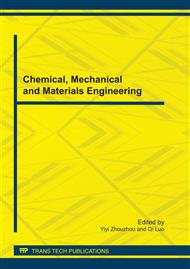[1]
S.M. Ashekuzzaman, Tjalfe G. Poulsen. Optimizing feed composition for improved methane yield during anaerobic digestion of cow manure based waste mixtures. Bioresource Technology, 102(2011), p.2213~2218.
DOI: 10.1016/j.biortech.2010.09.118
Google Scholar
[2]
Hossain, G.M.M. Improved cookstove and biogas programmes in Bangladesh. Energy Sustain. Dev. VII (2)(2003).
Google Scholar
[3]
Lema, J.M., Omil, F. Anaerobic treatment: a keytechnology for a sustainable management of wastes inEurope. Water Sci. Technol. 44 (2001), p.133~140.
DOI: 10.2166/wst.2001.0483
Google Scholar
[4]
Hinrich Hartmann, Birgitte K. Ahring. Anaerobic digestion of the organic fraction of municipal solid wast: Influence of co-digestion with manure. Water Research, 39(2005), p.1543~1552.
DOI: 10.1016/j.watres.2005.02.001
Google Scholar
[5]
De Baere, L. Anaerobic digestion of solid waste: state-of-the-art. Water Sci. Technol. 41 (2000), p.283~290.
Google Scholar
[6]
J. Guendouz, P. Buffière, J. Cacho, M. Carrère, J.P. Delgenes. Dry anaerobic digestion in batch mode: Design and operation of a laboratory-scale, completely mixed reactor. Waste Management, 2010, 30(10): 1768~1771.
DOI: 10.1016/j.wasman.2009.12.024
Google Scholar
[7]
Ronan Le Hyaric, Caroline Chardin, Hassen Benbelkacem, et al. Influence of substrate concentration and moisture content on the specific methanogenic activity of dry mesophilic municipal solid waste digestate spiked with propionate. Bioresource Technology, 102(2011).
DOI: 10.1016/j.biortech.2010.08.124
Google Scholar
[8]
Buffière, P., Loisel, D., Bernet, N., Delgenes, J.P. Towards new indicators for the prediction of solid waste anaerobic digestion properties. Water Sci. Technol. 53(2006), p.233~241.
DOI: 10.2166/wst.2006.254
Google Scholar
[9]
Lopes, W.S., Leite, V.D., Prasad, S. Influence of inoculum on performance of anaerobic reactors for treating municipal solid waste. Biores. Technol. 94(2004), p.261~266.
DOI: 10.1016/j.biortech.2004.01.006
Google Scholar
[10]
T. Forster-Carneiro, M. Pe´rez, L.I. Romero. Influence of total solid and inoculum contents on performanceof anaerobic reactors treating food waste. Biores. Technol. 99(2008), p.6994~7002.
DOI: 10.1016/j.biortech.2008.01.018
Google Scholar


